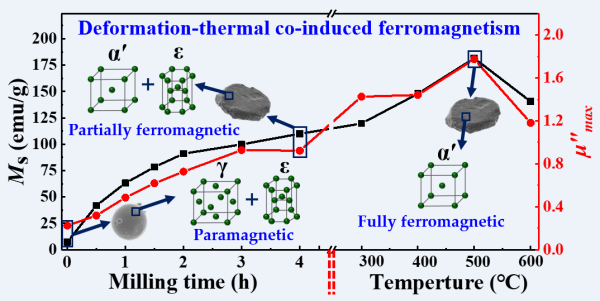付子文和陈志宏等撰写的研究论文“Deformation-thermal co-induced ferromagnetism of austenite nanocrystalline FeCoCr powders for strong microwave absorp-tion”被期刊Nanomaterials(2021年影响因子IF:5.076)接收!
软磁合金可对电磁波同时产生磁、介电损耗,且具有良好的耐环境性能,是制备“薄、轻、宽、强”的耐环境雷达吸波涂层的重要吸波剂。然而,当FeCoCr合金处于奥氏体相时,由于顺磁性将失去磁损耗能力和吸波性能,因而其奥氏体相合金粒子通常不在吸波剂遴选范围。针对该问题,我们在该工作中提出形变-热协同诱导转变为马氏体相这一简便方法,即奥氏体FeCoCr合金粉末在力化学片化过程中会产生显著的马氏体相变,随后的热处理会进一步提高马氏体含量,最终使FeCoCr粒子的饱和磁化强度从1.43 emu/g(顺磁性)提高到181.58 emu/g(强铁磁性),提升近130倍。形变-热诱导马氏体相变后的产物吸波剂能展现优良的吸波性能和耐温性能:在厚度为1 mm时,在8~18 GHz范围内的反射损耗小于-6 dB,且可在300℃下保持稳定的电磁性能。该研究工作可将合金吸波剂选择范围拓展到304/316L等不锈钢体系以及其他奥氏体合金体系中,对于提升工业废品的软磁性能和增值利用具有重要意义。
原文摘要如下:Nanocrystalline soft magnetic alloy powders are promising microwave absorbents, since they can work at diverse frequency and be stable in harsh environments. However, when the alloy powders are in austenite phase, they are out of the screen for microwave absorbents due to their paramagnetic nature. In this work, we reported a strategy to enable strong microwave absorption in nanocrystalline austenite FeCoCr powders by deformation-thermal co-induced ferromagnetism via attritor ball milling and subsequent heat treatment. Results showed that significant austenite-to-martensite transformation in FeCoCr powders was achieved during ball milling, along with the increase of shape anisotropy from spherical to flaky. The saturation magnetization followed a parabolic kinetics during ball milling and rose from 1.43 to 109.92 emu/g after milling for 4 h, while it exhibited rapid increase to 181.58 emu/g after subsequent heat treatment at 500 °C. Considerable increase of complex permeability and hence magnetic loss capability was obtained. With appropriate modulation of complex permittivity, the resultant absorbents showed reflection loss of below -6 dB over 8 ~ 18 GHz at thickness of 1 mm and superior stability at 300 oC. Our strategy can broaden the material selection for microwave absorbents by involving Fe-based austenite alloys and simply recover ferromagnetism of industrial products made without proper control of crystalline phase.



